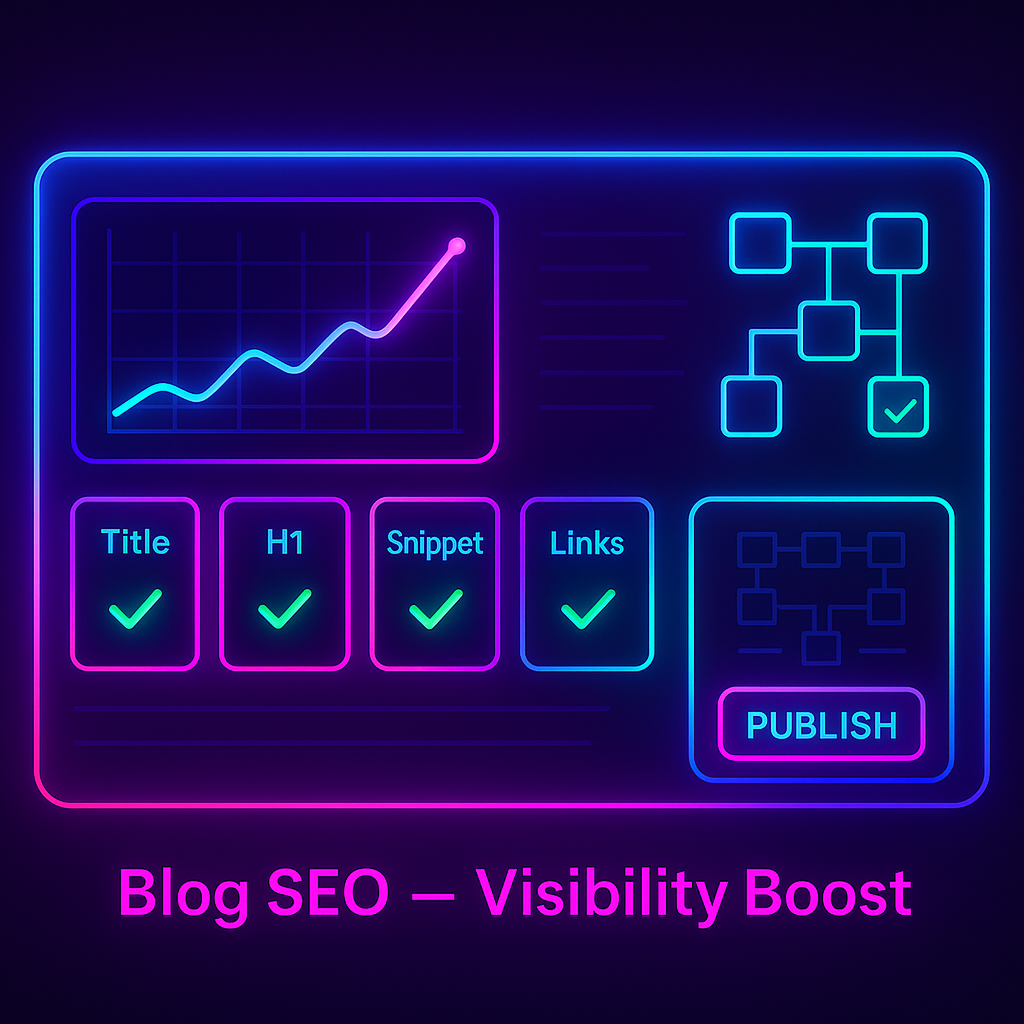A practical, expert-led Blog SEO playbook for 2025. Learn how to plan topics, write titles/H1s that win clicks, add snippet paragraphs, fix internal links, ship lean schema, and keep posts fast—using SEO Horizan tools for quick QA.
Blog SEO — Boost Your Site’s Visibility (Expert Playbook)
Great blogs don’t win by luck—they win with repeatable SEO habits. This guide gives you a field-tested process to plan topics, write titles and H1s that earn clicks, add a crisp snippet paragraph, fix internal links, ship lean schema, and keep pages fast. Every step is paired with quick QA using SEO Horizan tools so you can publish with confidence.
The 7 blog SEO levers that actually move the needle
- Clear search intent: Map each post to one job (how-to, template, comparison, benchmark, pricing explainer).
- Titles & H1s that align: Sell the outcome in ~55–60 characters; mirror it in your H1.
- Snippet paragraph: 40–55 words under H1 telling readers (and summaries) what they’ll get.
- Internal links: Contextual anchors that route to hubs, templates, and conversion paths.
- Proof assets: Tables, screenshots, downloads—useful > verbose.
- Lean schema: Only what matches visible content (BlogPosting/FAQPage where applicable).
- Speed & stability: TTFB < 600 ms; < 2 MB payload; no redirect hops.
Fast workflow (30–60 minutes per post)
- Pick the intent: Choose How-to, Template, Comparison, or Benchmark. Keep it single-purpose.
- Draft a title + meta: Preview the SERP fit in Google Search Preview.
- Check parity: Validate title/description/canonical with Meta Tags Checker and social cards with OpenGraph Checker.
- Write the snippet paragraph: Place it right under the H1; confirm presence via Website Text Extractor.
- Add 2–4 internal links: Use descriptive anchors; confirm final 200 with URL Redirect Checker and headers via HTTP Headers Lookup.
- Keep it light: Check size and TTFB with Website Page Size Checker and TTFB Checker.
- Optional schema: Add
BlogPostingorFAQPageonly if content matches.
Title patterns that win (copy, then tailor)
- [Topic] Template + Example (2025)
- [X] vs [Y]: key differences, pricing & use cases
- [Metric] benchmarks for [Audience] (2025 report)
- [Task]: step-by-step + checklist (2025)
Tip: Front-load the task/object; keep the brand at the tail unless it’s a branded search.
H1 + snippet paragraph (your clarity combo)
<h1>[Topic]: step-by-step + examples (2025)</h1>
<p class="snippet">[40–55 words: who this is for, the outcome they get, and the 2–3 steps/tools you’ll use. Keep it plain and scannable.]</p>
Internal links that convert
- Use anchors readers would say out loud (e.g., “download the [topic] template”).
- Place 1–2 links in the intro and 1–2 near your first proof asset.
- Verify each link hits a final 200 (no hops) with URL Redirect Checker.
Proof assets (at least one above the fold)
- Comparison table, editable template, calculator screenshot, or concise example.
- Compress images and set explicit width/height; validate alts with Image Alt Tags Checker.
Topical authority with light clusters
Build a hub → spoke model: one pillar that defines scope, and 4–8 posts for distinct intents. Interlink both ways, and ensure every link goes to a final URL.
Programmatic guardrails (safe automation)
IF type="template"
title="{{topic}} Template + Example (2025) — {{brand_short}}"
ELSE IF type="comparison"
title="{{x}} vs {{y}}: key differences & pricing — {{brand_short}}"
ELSE IF type="benchmark"
title="{{metric}} benchmarks for {{audience}} (2025) — {{brand_short}}"
ELSE
title="{{task}}: {{outcome}} (2025) — {{brand_short}}"
Rules: 60–65 char soft cap; dedupe tokens; keep brand at tail; preview visually.
Lean schema (only when visible content matches)
- Use
BlogPostingfor most guides;FAQPageonly when Q&A is on-page. - Never stuff promotional copy in JSON-LD; mirror visible text.
{
"@context":"https://schema.org",
"@type":"BlogPosting",
"headline":"[Title]",
"description":"[Snippet paragraph]",
"mainEntityOfPage":"https://example.com/blog/[slug]"
}
Blog layout checklist (UX + E-E-A-T)
- Experience: Screenshots/GIFs of the real workflow.
- Expertise: Clear steps, pitfalls, and decision criteria.
- Authoritativeness: Cite standards; link to your data/benchmarks.
- Trust: Redirect-free CTAs; visible policy pages; fast page.
Copy-paste components
“Next steps” block
<aside class="next-steps">
<h3>Next steps</h3>
<ul>
<li><a href="/blog/[template]">Download the [topic] template</a></li>
<li><a href="/blog/[comparison]">[X] vs [Y] comparison</a></li>
<li><a href="/plan">Choose your plan</a></li>
</ul>
</aside>
Editor worksheet (CSV header)
URL, Title OK (Y/N), H1 OK (Y/N), Snippet (Y/N), Proof Asset (Y/N), Intro Links Final-200 (Y/N), TTFB<600ms (Y/N), <2MB (Y/N), Schema Valid (Y/N), Owner, Live Date
Ten-minute QA loop before publishing
- Preview snippet fit in Google Search Preview.
- Verify meta/OG and canonical with Meta Tags Checker and OpenGraph Checker.
- Confirm snippet paragraph via Website Text Extractor.
- Test internal links with URL Redirect Checker; check headers in HTTP Headers Lookup.
- Measure size and TTFB with Website Page Size Checker and TTFB Checker.
Where to link internally (for conversions & crawl)
- Blog hub for related guides and deep dives.
- Plans for pricing/limits when tools are referenced.
- Sign-up or Login where appropriate.
- Ensure important posts/hubs are in your Sitemap.
SEO Horizan Toolbox (bookmark these)
- Google Search Preview • Meta Tags Checker • OpenGraph Checker
- Website Text Extractor • URL Redirect Checker • HTTP Headers Lookup
- Image Alt Tags Checker • Website Page Size Checker • TTFB Checker
- Noindex Checker • URL Redirect Checker
FAQs
How long should a blog post be for SEO?
As long as it needs to solve the job—quality over word count. Ensure a clear snippet paragraph, one proof asset, and redirect-free internal links.
Do I need FAQ schema on every post?
No. Add FAQPage only when visible Q&A exists and the JSON-LD matches the text.
Where should I place internal links?
Near the intro and after your first proof asset. Use descriptive anchors and verify final 200s.
What’s the fastest Blog SEO win?
Rewrite title for intent + outcome, add a 40–55 word snippet under H1, and fix redirecting internal links.
Wrap-up
Blog SEO isn’t magic; it’s a checklist you can run every week. Align title-H1, add a crisp snippet, include a proof asset, wire internal links, ship lean schema, and keep pages fast. Use the toolset above to QA in minutes—then publish and move to the next post.
